Ontario, WI Map & Demographics
Ontario Map
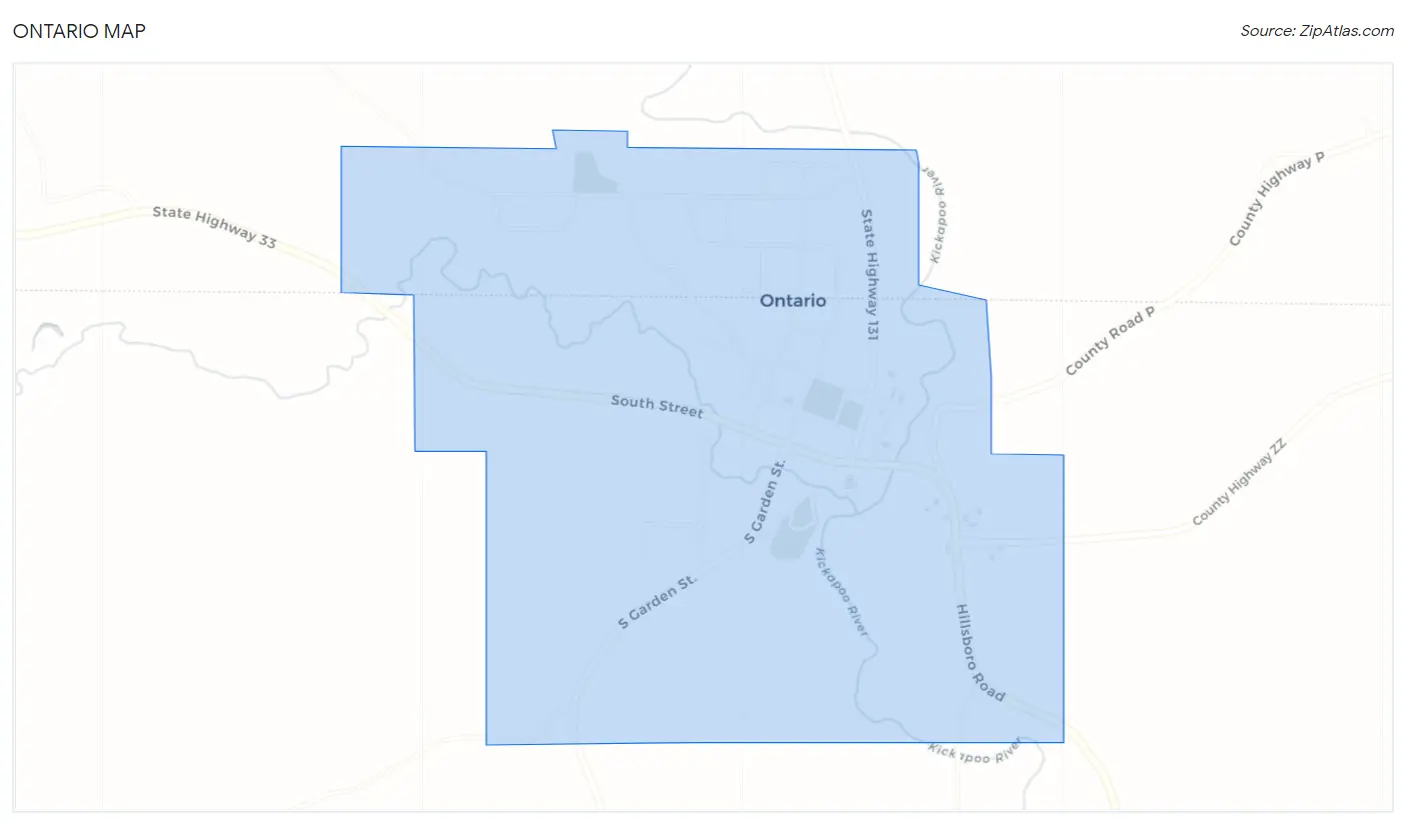
Ontario Overview
$25,525
PER CAPITA INCOME
$88,571
AVG FAMILY INCOME
$57,500
AVG HOUSEHOLD INCOME
29.2%
WAGE / INCOME GAP [ % ]
70.8¢/ $1
WAGE / INCOME GAP [ $ ]
0.35
INEQUALITY / GINI INDEX
415
TOTAL POPULATION
180
MALE POPULATION
235
FEMALE POPULATION
76.60
MALES / 100 FEMALES
130.56
FEMALES / 100 MALES
34.0
MEDIAN AGE
3.6
AVG FAMILY SIZE
2.4
AVG HOUSEHOLD SIZE
182
LABOR FORCE [ PEOPLE ]
62.1%
PERCENT IN LABOR FORCE
1.1%
UNEMPLOYMENT RATE
Ontario Zip Codes
Ontario Area Codes
Income in Ontario
Income Overview in Ontario
Per Capita Income in Ontario is $25,525, while median incomes of families and households are $88,571 and $57,500 respectively.
| Characteristic | Number | Measure |
| Per Capita Income | 415 | $25,525 |
| Median Family Income | 92 | $88,571 |
| Mean Family Income | 92 | $85,337 |
| Median Household Income | 170 | $57,500 |
| Mean Household Income | 170 | $66,798 |
| Income Deficit | 92 | $0 |
| Wage / Income Gap (%) | 415 | 29.22% |
| Wage / Income Gap ($) | 415 | 70.78¢ per $1 |
| Gini / Inequality Index | 415 | 0.35 |
Earnings by Sex in Ontario
Average Earnings in Ontario are $42,857, $45,625 for men and $32,292 for women, a difference of 29.2%.

| Sex | Number | Average Earnings |
| Male | 120 (60.6%) | $45,625 |
| Female | 78 (39.4%) | $32,292 |
| Total | 198 (100.0%) | $42,857 |
Earnings by Sex by Income Bracket in Ontario
The most common earnings brackets in Ontario are $55,000 to $64,999 for men (21 | 17.5%) and $30,000 to $34,999 for women (14 | 17.9%).
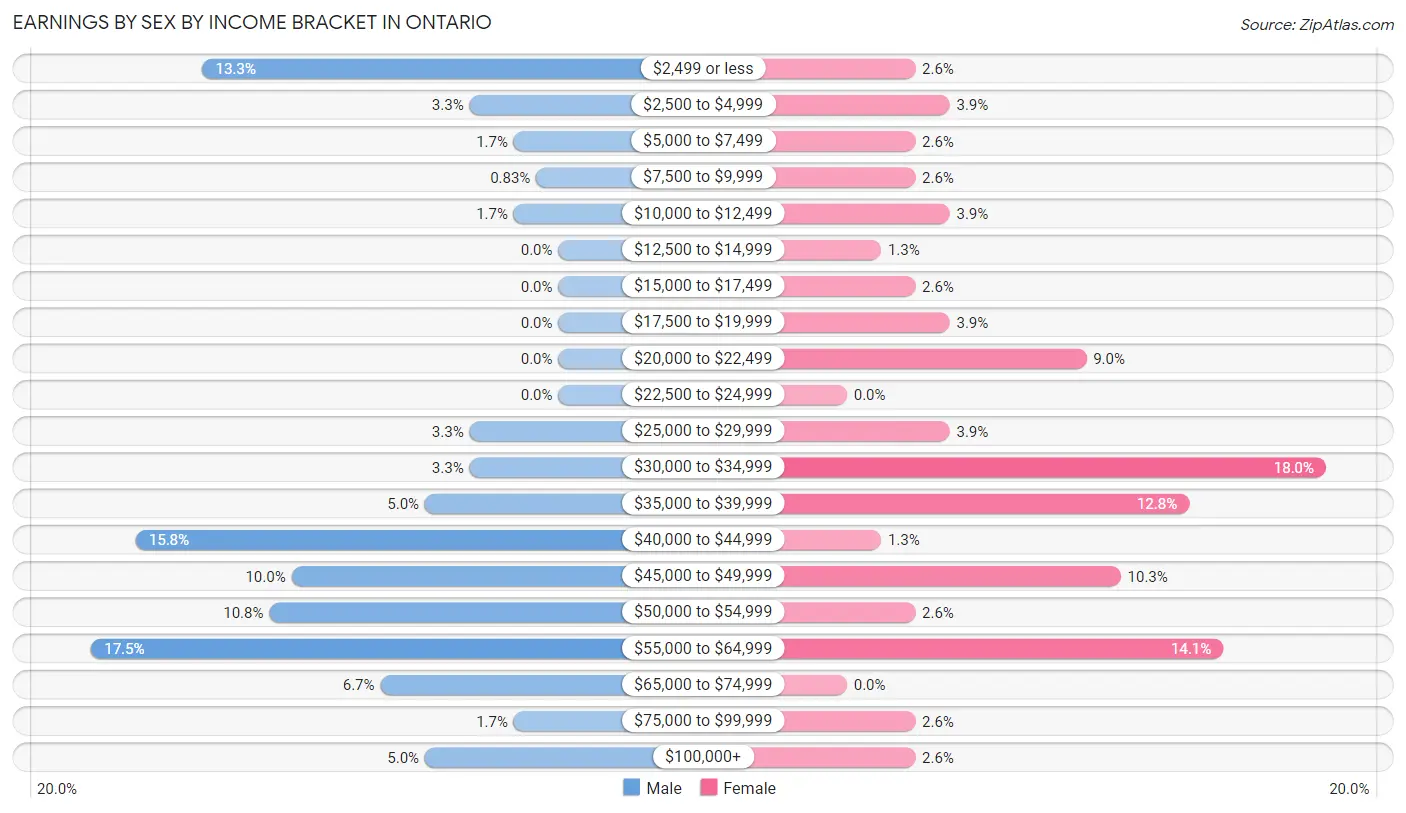
| Income | Male | Female |
| $2,499 or less | 16 (13.3%) | 2 (2.6%) |
| $2,500 to $4,999 | 4 (3.3%) | 3 (3.8%) |
| $5,000 to $7,499 | 2 (1.7%) | 2 (2.6%) |
| $7,500 to $9,999 | 1 (0.8%) | 2 (2.6%) |
| $10,000 to $12,499 | 2 (1.7%) | 3 (3.8%) |
| $12,500 to $14,999 | 0 (0.0%) | 1 (1.3%) |
| $15,000 to $17,499 | 0 (0.0%) | 2 (2.6%) |
| $17,500 to $19,999 | 0 (0.0%) | 3 (3.8%) |
| $20,000 to $22,499 | 0 (0.0%) | 7 (9.0%) |
| $22,500 to $24,999 | 0 (0.0%) | 0 (0.0%) |
| $25,000 to $29,999 | 4 (3.3%) | 3 (3.8%) |
| $30,000 to $34,999 | 4 (3.3%) | 14 (17.9%) |
| $35,000 to $39,999 | 6 (5.0%) | 10 (12.8%) |
| $40,000 to $44,999 | 19 (15.8%) | 1 (1.3%) |
| $45,000 to $49,999 | 12 (10.0%) | 8 (10.3%) |
| $50,000 to $54,999 | 13 (10.8%) | 2 (2.6%) |
| $55,000 to $64,999 | 21 (17.5%) | 11 (14.1%) |
| $65,000 to $74,999 | 8 (6.7%) | 0 (0.0%) |
| $75,000 to $99,999 | 2 (1.7%) | 2 (2.6%) |
| $100,000+ | 6 (5.0%) | 2 (2.6%) |
| Total | 120 (100.0%) | 78 (100.0%) |
Earnings by Sex by Educational Attainment in Ontario
Average earnings in Ontario are $50,625 for men and $35,500 for women, a difference of 29.9%. Men with an educational attainment of college or associate's degree enjoy the highest average annual earnings of $61,875, while those with less than high school education earn the least with $43,523. Women with an educational attainment of bachelor's degree earn the most with the average annual earnings of $52,500, while those with high school diploma education have the smallest earnings of $21,875.

| Educational Attainment | Male Income | Female Income |
| Less than High School | $43,523 | $31,250 |
| High School Diploma | $48,750 | $21,875 |
| College or Associate's Degree | $61,875 | $36,250 |
| Bachelor's Degree | $53,333 | $52,500 |
| Graduate Degree | - | - |
| Total | $50,625 | $35,500 |
Family Income in Ontario
Family Income Brackets in Ontario
According to the Ontario family income data, there are 30 families falling into the $100,000 to $149,999 income range, which is the most common income bracket and makes up 32.6% of all families.

| Income Bracket | # Families | % Families |
| Less than $10,000 | 0 | 0.0% |
| $10,000 to $14,999 | 1 | 1.1% |
| $15,000 to $24,999 | 0 | 0.0% |
| $25,000 to $34,999 | 6 | 6.5% |
| $35,000 to $49,999 | 16 | 17.4% |
| $50,000 to $74,999 | 13 | 14.1% |
| $75,000 to $99,999 | 22 | 23.9% |
| $100,000 to $149,999 | 30 | 32.6% |
| $150,000 to $199,999 | 4 | 4.3% |
| $200,000+ | 0 | 0.0% |
Family Income by Famaliy Size in Ontario
5-person families (18 | 19.6%) account for the highest median family income in Ontario with $125,625 per family, while 2-person families (40 | 43.5%) have the highest median income of $27,084 per family member.

| Income Bracket | # Families | Median Income |
| 2-Person Families | 40 (43.5%) | $54,167 |
| 3-Person Families | 10 (10.9%) | $0 |
| 4-Person Families | 8 (8.7%) | $78,750 |
| 5-Person Families | 18 (19.6%) | $125,625 |
| 6-Person Families | 13 (14.1%) | $115,417 |
| 7+ Person Families | 3 (3.3%) | $0 |
| Total | 92 (100.0%) | $88,571 |
Family Income by Number of Earners in Ontario
The median family income in Ontario is $88,571, with families comprising 2 earners (36) having the highest median family income of $91,667, while families with no earners (8) have the lowest median family income of $36,250, accounting for 39.1% and 8.7% of families, respectively.

| Number of Earners | # Families | Median Income |
| No Earners | 8 (8.7%) | $36,250 |
| 1 Earner | 34 (37.0%) | $90,000 |
| 2 Earners | 36 (39.1%) | $91,667 |
| 3+ Earners | 14 (15.2%) | $87,500 |
| Total | 92 (100.0%) | $88,571 |
Household Income in Ontario
Household Income Brackets in Ontario
With 34 households falling in the category, the $75,000 to $99,999 income range is the most frequent in Ontario, accounting for 20.0% of all households.

| Income Bracket | # Households | % Households |
| Less than $10,000 | 5 | 2.9% |
| $10,000 to $14,999 | 12 | 7.1% |
| $15,000 to $24,999 | 13 | 7.6% |
| $25,000 to $34,999 | 13 | 7.6% |
| $35,000 to $49,999 | 33 | 19.4% |
| $50,000 to $74,999 | 23 | 13.5% |
| $75,000 to $99,999 | 34 | 20.0% |
| $100,000 to $149,999 | 30 | 17.6% |
| $150,000 to $199,999 | 7 | 4.1% |
| $200,000+ | 0 | 0.0% |
Household Income by Householder Age in Ontario
The median household income in Ontario is $57,500, with the highest median household income of $90,000 found in the 25 to 44 years age bracket for the primary householder. A total of 64 households (37.7%) fall into this category. Meanwhile, the 15 to 24 years age bracket for the primary householder has the lowest median household income of $0, with 2 households (1.2%) in this group.

| Income Bracket | # Households | Median Income |
| 15 to 24 Years | 2 (1.2%) | $0 |
| 25 to 44 Years | 64 (37.7%) | $90,000 |
| 45 to 64 Years | 48 (28.2%) | $56,250 |
| 65+ Years | 56 (32.9%) | $25,625 |
| Total | 170 (100.0%) | $57,500 |
Poverty in Ontario
Income Below Poverty by Sex and Age in Ontario
With 1.7% poverty level for males and 6.4% for females among the residents of Ontario, 25 to 34 year old males and 75 year old and over females are the most vulnerable to poverty, with 3 males (13.6%) and 8 females (34.8%) in their respective age groups living below the poverty level.
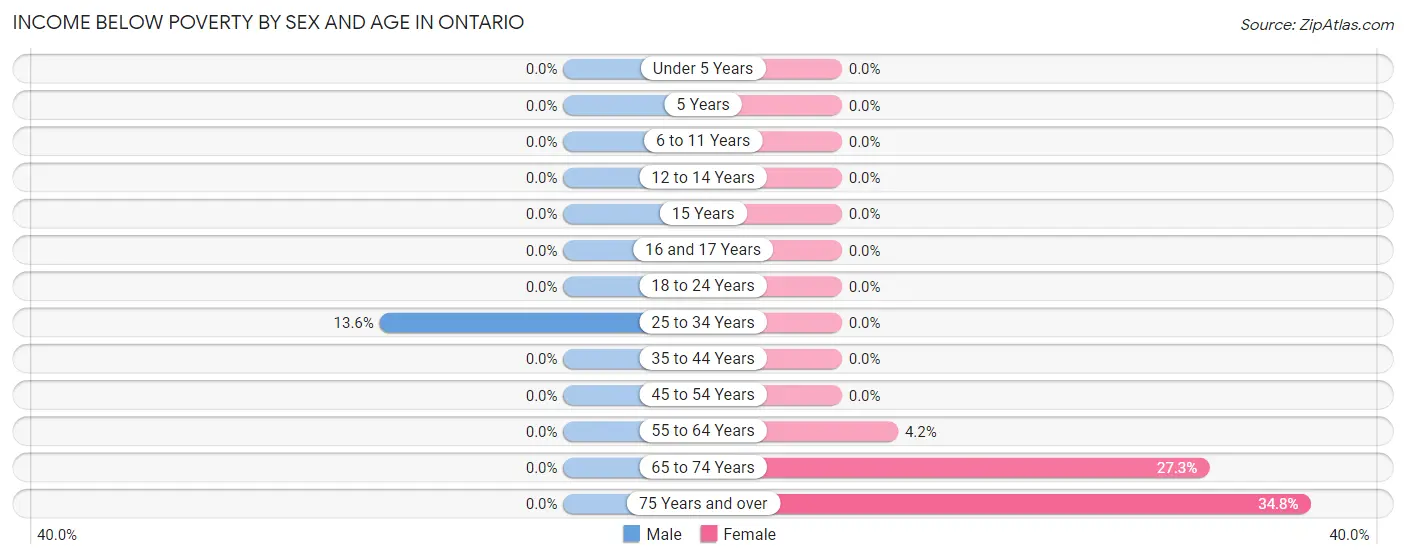
| Age Bracket | Male | Female |
| Under 5 Years | 0 (0.0%) | 0 (0.0%) |
| 5 Years | 0 (0.0%) | 0 (0.0%) |
| 6 to 11 Years | 0 (0.0%) | 0 (0.0%) |
| 12 to 14 Years | 0 (0.0%) | 0 (0.0%) |
| 15 Years | 0 (0.0%) | 0 (0.0%) |
| 16 and 17 Years | 0 (0.0%) | 0 (0.0%) |
| 18 to 24 Years | 0 (0.0%) | 0 (0.0%) |
| 25 to 34 Years | 3 (13.6%) | 0 (0.0%) |
| 35 to 44 Years | 0 (0.0%) | 0 (0.0%) |
| 45 to 54 Years | 0 (0.0%) | 0 (0.0%) |
| 55 to 64 Years | 0 (0.0%) | 1 (4.2%) |
| 65 to 74 Years | 0 (0.0%) | 6 (27.3%) |
| 75 Years and over | 0 (0.0%) | 8 (34.8%) |
| Total | 3 (1.7%) | 15 (6.4%) |
Income Above Poverty by Sex and Age in Ontario
According to the poverty statistics in Ontario, males aged under 5 years and females aged under 5 years are the age groups that are most secure financially, with 100.0% of males and 100.0% of females in these age groups living above the poverty line.
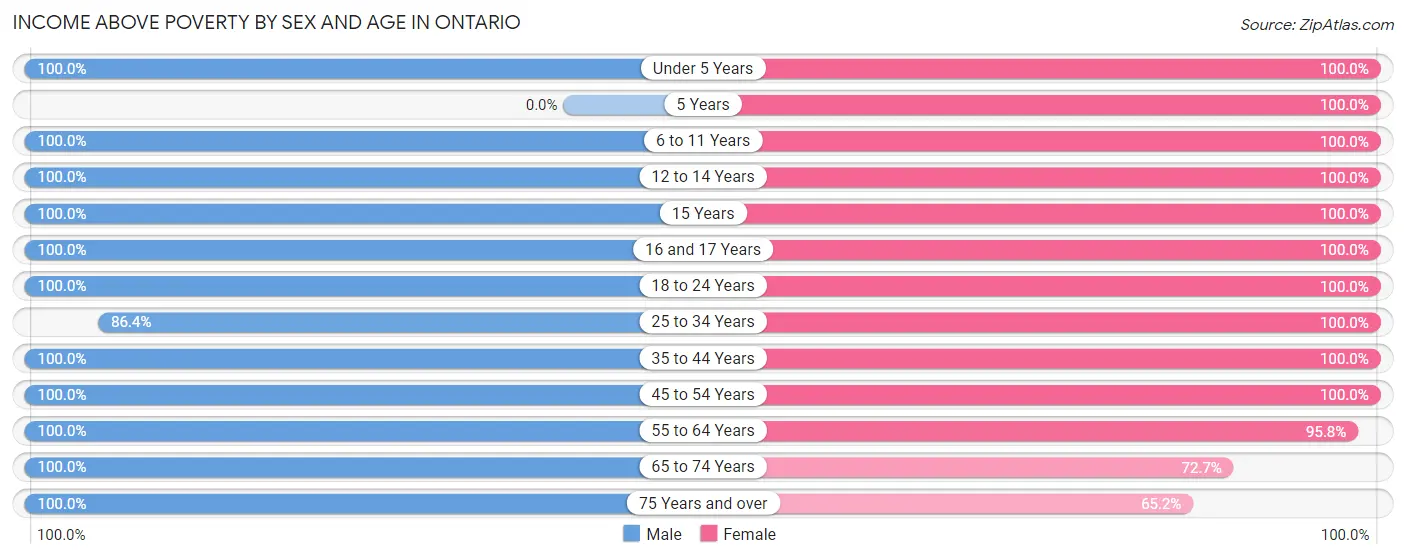
| Age Bracket | Male | Female |
| Under 5 Years | 10 (100.0%) | 24 (100.0%) |
| 5 Years | 0 (0.0%) | 3 (100.0%) |
| 6 to 11 Years | 6 (100.0%) | 32 (100.0%) |
| 12 to 14 Years | 7 (100.0%) | 26 (100.0%) |
| 15 Years | 12 (100.0%) | 2 (100.0%) |
| 16 and 17 Years | 11 (100.0%) | 4 (100.0%) |
| 18 to 24 Years | 16 (100.0%) | 6 (100.0%) |
| 25 to 34 Years | 19 (86.4%) | 27 (100.0%) |
| 35 to 44 Years | 27 (100.0%) | 27 (100.0%) |
| 45 to 54 Years | 22 (100.0%) | 15 (100.0%) |
| 55 to 64 Years | 23 (100.0%) | 23 (95.8%) |
| 65 to 74 Years | 10 (100.0%) | 16 (72.7%) |
| 75 Years and over | 14 (100.0%) | 15 (65.2%) |
| Total | 177 (98.3%) | 220 (93.6%) |
Income Below Poverty Among Married-Couple Families in Ontario

| Children | Above Poverty | Below Poverty |
| No Children | 38 (100.0%) | 0 (0.0%) |
| 1 or 2 Children | 8 (100.0%) | 0 (0.0%) |
| 3 or 4 Children | 31 (100.0%) | 0 (0.0%) |
| 5 or more Children | 3 (100.0%) | 0 (0.0%) |
| Total | 80 (100.0%) | 0 (0.0%) |
Income Below Poverty Among Single-Parent Households in Ontario

| Children | Single Father | Single Mother |
| No Children | 0 (0.0%) | 1 (100.0%) |
| 1 or 2 Children | 0 (0.0%) | 0 (0.0%) |
| 3 or 4 Children | 0 (0.0%) | 0 (0.0%) |
| 5 or more Children | 0 (0.0%) | 0 (0.0%) |
| Total | 0 (0.0%) | 1 (10.0%) |
Income Below Poverty Among Married-Couple vs Single-Parent Households in Ontario

| Children | Married-Couple Families | Single-Parent Households |
| No Children | 0 (0.0%) | 1 (33.3%) |
| 1 or 2 Children | 0 (0.0%) | 0 (0.0%) |
| 3 or 4 Children | 0 (0.0%) | 0 (0.0%) |
| 5 or more Children | 0 (0.0%) | 0 (0.0%) |
| Total | 0 (0.0%) | 1 (8.3%) |
Race in Ontario
The most populous races in Ontario are White / Caucasian (362 | 87.2%), Hispanic or Latino (39 | 9.4%), and Two or more Races (25 | 6.0%).

| Race | # Population | % Population |
| Asian | 12 | 2.9% |
| Black / African American | 0 | 0.0% |
| Hawaiian / Pacific | 0 | 0.0% |
| Hispanic or Latino | 39 | 9.4% |
| Native / Alaskan | 0 | 0.0% |
| White / Caucasian | 362 | 87.2% |
| Two or more Races | 25 | 6.0% |
| Some other Race | 16 | 3.9% |
| Total | 415 | 100.0% |
Ancestry in Ontario
The most populous ancestries reported in Ontario are German (157 | 37.8%), Norwegian (39 | 9.4%), Scottish (37 | 8.9%), English (34 | 8.2%), and Irish (30 | 7.2%), together accounting for 71.6% of all Ontario residents.
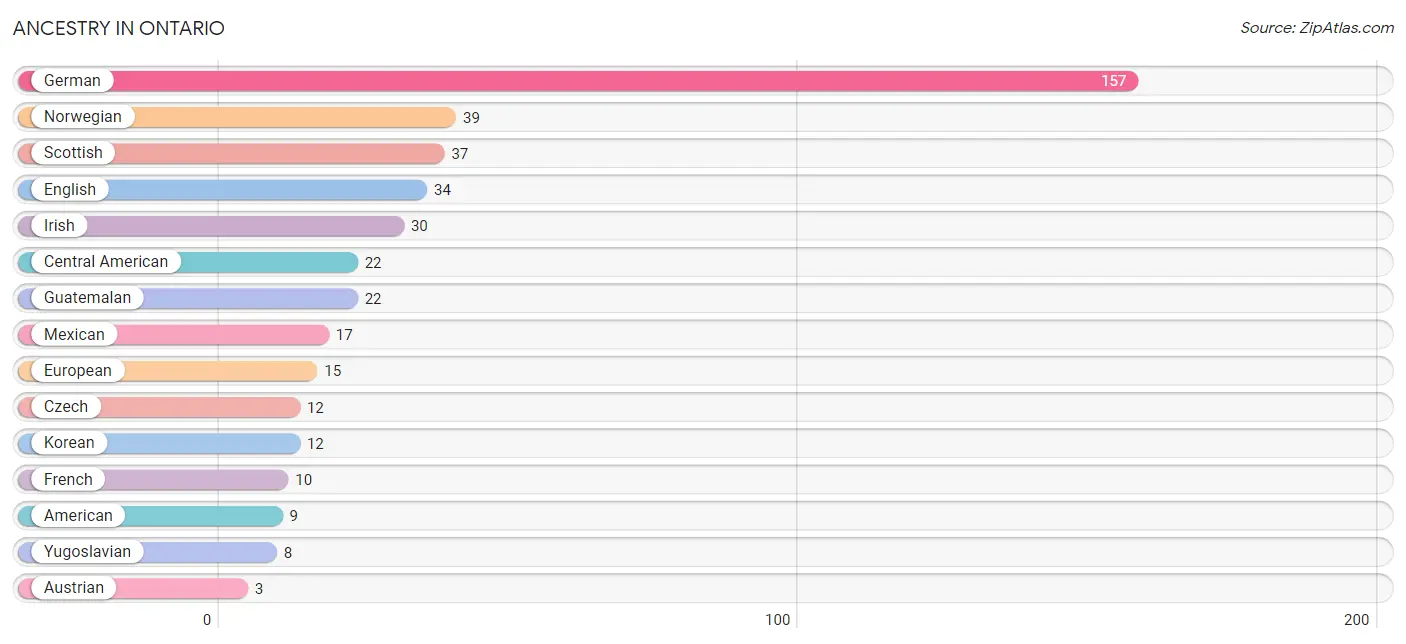
| Ancestry | # Population | % Population |
| American | 9 | 2.2% |
| Austrian | 3 | 0.7% |
| Central American | 22 | 5.3% |
| Czech | 12 | 2.9% |
| Danish | 2 | 0.5% |
| English | 34 | 8.2% |
| European | 15 | 3.6% |
| French | 10 | 2.4% |
| German | 157 | 37.8% |
| Guatemalan | 22 | 5.3% |
| Irish | 30 | 7.2% |
| Korean | 12 | 2.9% |
| Mexican | 17 | 4.1% |
| Norwegian | 39 | 9.4% |
| Polish | 2 | 0.5% |
| Scandinavian | 2 | 0.5% |
| Scotch-Irish | 2 | 0.5% |
| Scottish | 37 | 8.9% |
| Welsh | 2 | 0.5% |
| Yugoslavian | 8 | 1.9% | View All 20 Rows |
Immigrants in Ontario
The most numerous immigrant groups reported in Ontario came from Central America (13 | 3.1%), Latin America (13 | 3.1%), Asia (12 | 2.9%), Philippines (12 | 2.9%), and South Eastern Asia (12 | 2.9%), together accounting for 14.9% of all Ontario residents.

| Immigration Origin | # Population | % Population |
| Asia | 12 | 2.9% |
| Central America | 13 | 3.1% |
| Guatemala | 4 | 1.0% |
| Latin America | 13 | 3.1% |
| Mexico | 9 | 2.2% |
| Philippines | 12 | 2.9% |
| South Eastern Asia | 12 | 2.9% | View All 7 Rows |
Sex and Age in Ontario
Sex and Age in Ontario
The most populous age groups in Ontario are 15 to 19 Years (33 | 18.3%) for men and 10 to 14 Years (39 | 16.6%) for women.
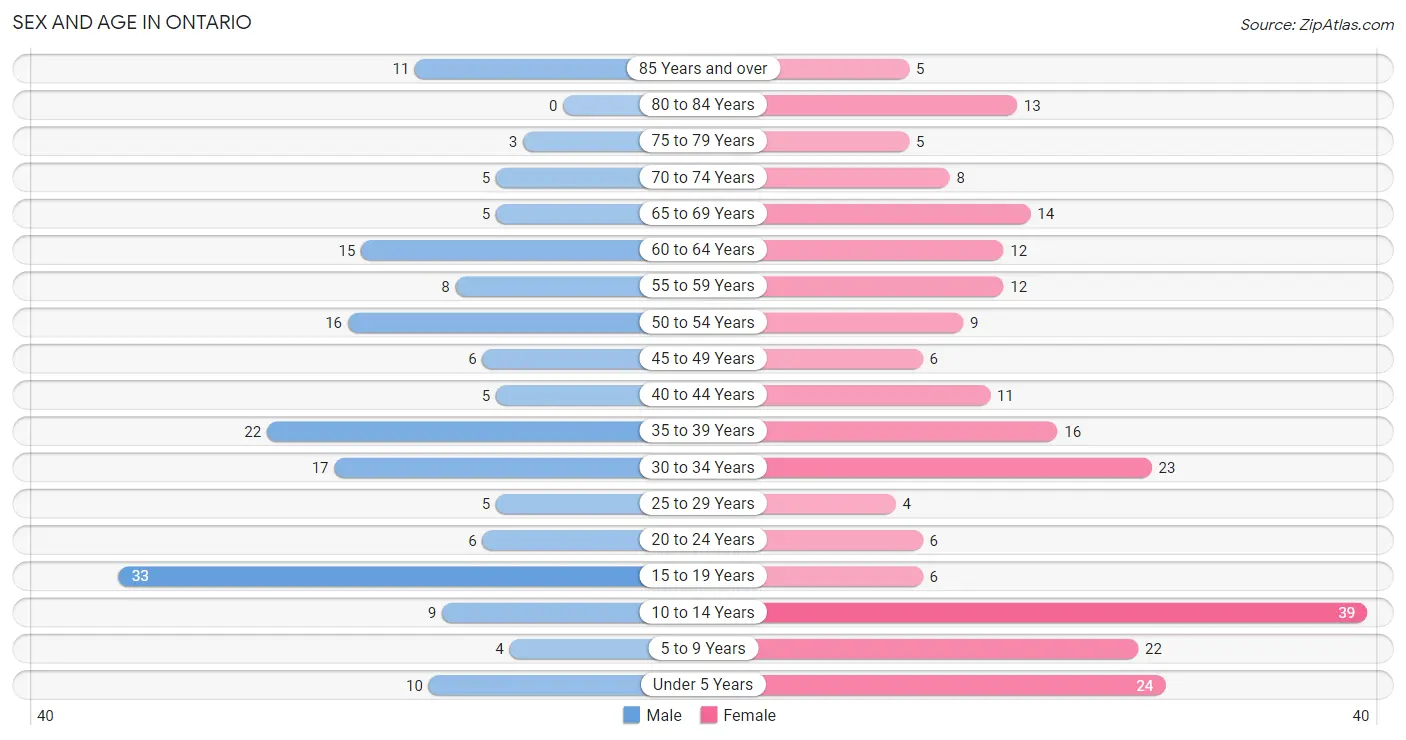
| Age Bracket | Male | Female |
| Under 5 Years | 10 (5.6%) | 24 (10.2%) |
| 5 to 9 Years | 4 (2.2%) | 22 (9.4%) |
| 10 to 14 Years | 9 (5.0%) | 39 (16.6%) |
| 15 to 19 Years | 33 (18.3%) | 6 (2.5%) |
| 20 to 24 Years | 6 (3.3%) | 6 (2.5%) |
| 25 to 29 Years | 5 (2.8%) | 4 (1.7%) |
| 30 to 34 Years | 17 (9.4%) | 23 (9.8%) |
| 35 to 39 Years | 22 (12.2%) | 16 (6.8%) |
| 40 to 44 Years | 5 (2.8%) | 11 (4.7%) |
| 45 to 49 Years | 6 (3.3%) | 6 (2.5%) |
| 50 to 54 Years | 16 (8.9%) | 9 (3.8%) |
| 55 to 59 Years | 8 (4.4%) | 12 (5.1%) |
| 60 to 64 Years | 15 (8.3%) | 12 (5.1%) |
| 65 to 69 Years | 5 (2.8%) | 14 (6.0%) |
| 70 to 74 Years | 5 (2.8%) | 8 (3.4%) |
| 75 to 79 Years | 3 (1.7%) | 5 (2.1%) |
| 80 to 84 Years | 0 (0.0%) | 13 (5.5%) |
| 85 Years and over | 11 (6.1%) | 5 (2.1%) |
| Total | 180 (100.0%) | 235 (100.0%) |
Families and Households in Ontario
Median Family Size in Ontario
The median family size in Ontario is 3.57 persons per family, with single female/mother families (10 | 10.9%) accounting for the largest median family size of 4.3 persons per family. On the other hand, single male/father families (2 | 2.2%) represent the smallest median family size with 2.00 persons per family.

| Family Type | # Families | Family Size |
| Married-Couple | 80 (87.0%) | 3.51 |
| Single Male/Father | 2 (2.2%) | 2.00 |
| Single Female/Mother | 10 (10.9%) | 4.30 |
| Total Families | 92 (100.0%) | 3.57 |
Median Household Size in Ontario
The median household size in Ontario is 2.44 persons per household, with single female/mother households (10 | 5.9%) accounting for the largest median household size of 4.3 persons per household. non-family households (78 | 45.9%) represent the smallest median household size with 1.12 persons per household.

| Household Type | # Households | Household Size |
| Married-Couple | 80 (47.1%) | 3.51 |
| Single Male/Father | 2 (1.2%) | 2.00 |
| Single Female/Mother | 10 (5.9%) | 4.30 |
| Non-family | 78 (45.9%) | 1.12 |
| Total Households | 170 (100.0%) | 2.44 |
Household Size by Marriage Status in Ontario
Out of a total of 170 households in Ontario, 92 (54.1%) are family households, while 78 (45.9%) are nonfamily households. The most numerous type of family households are 2-person households, comprising 40, and the most common type of nonfamily households are 1-person households, comprising 68.

| Household Size | Family Households | Nonfamily Households |
| 1-Person Households | - | 68 (40.0%) |
| 2-Person Households | 40 (23.5%) | 10 (5.9%) |
| 3-Person Households | 10 (5.9%) | 0 (0.0%) |
| 4-Person Households | 8 (4.7%) | 0 (0.0%) |
| 5-Person Households | 18 (10.6%) | 0 (0.0%) |
| 6-Person Households | 13 (7.6%) | 0 (0.0%) |
| 7+ Person Households | 3 (1.8%) | 0 (0.0%) |
| Total | 92 (54.1%) | 78 (45.9%) |
Female Fertility in Ontario
Fertility by Age in Ontario
Average fertility rate in Ontario is 222.0 births per 1,000 women. Women in the age bracket of 20 to 34 years have the highest fertility rate with 424.0 births per 1,000 women. Women in the age bracket of 20 to 34 years acount for 87.5% of all women with births.

| Age Bracket | Women with Births | Births / 1,000 Women |
| 15 to 19 years | 0 (0.0%) | 0.0 |
| 20 to 34 years | 14 (87.5%) | 424.0 |
| 35 to 50 years | 2 (12.5%) | 61.0 |
| Total | 16 (100.0%) | 222.0 |
Fertility by Age by Marriage Status in Ontario

| Age Bracket | Married | Unmarried |
| 15 to 19 years | 0 (0.0%) | 0 (0.0%) |
| 20 to 34 years | 14 (100.0%) | 0 (0.0%) |
| 35 to 50 years | 2 (100.0%) | 0 (0.0%) |
| Total | 16 (100.0%) | 0 (0.0%) |
Fertility by Education in Ontario
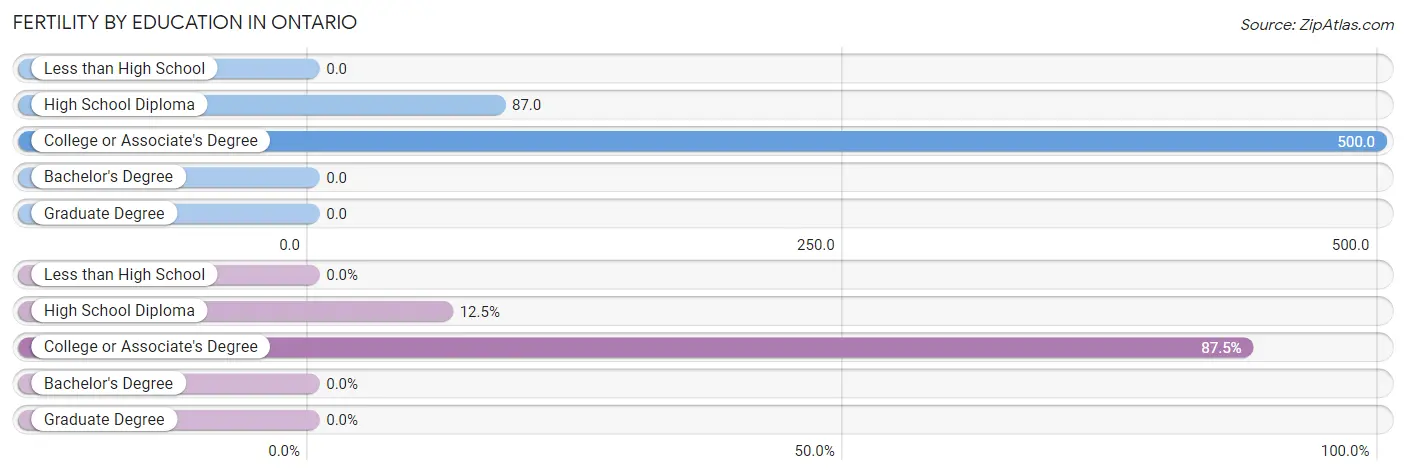
| Educational Attainment | Women with Births | Births / 1,000 Women |
| Less than High School | 0 (0.0%) | 0.0 |
| High School Diploma | 2 (12.5%) | 87.0 |
| College or Associate's Degree | 14 (87.5%) | 500.0 |
| Bachelor's Degree | 0 (0.0%) | 0.0 |
| Graduate Degree | 0 (0.0%) | 0.0 |
| Total | 16 (100.0%) | 222.0 |
Fertility by Education by Marriage Status in Ontario

| Educational Attainment | Married | Unmarried |
| Less than High School | 0 (0.0%) | 0 (0.0%) |
| High School Diploma | 2 (100.0%) | 0 (0.0%) |
| College or Associate's Degree | 14 (100.0%) | 0 (0.0%) |
| Bachelor's Degree | 0 (0.0%) | 0 (0.0%) |
| Graduate Degree | 0 (0.0%) | 0 (0.0%) |
| Total | 16 (100.0%) | 0 (0.0%) |
Employment Characteristics in Ontario
Employment by Class of Employer in Ontario
Among the 178 employed individuals in Ontario, private company employees (143 | 80.3%), local government employees (12 | 6.7%), and federal government employees (7 | 3.9%) make up the most common classes of employment.

| Employer Class | # Employees | % Employees |
| Private Company Employees | 143 | 80.3% |
| Self-Employed (Incorporated) | 2 | 1.1% |
| Self-Employed (Not Incorporated) | 6 | 3.4% |
| Not-for-profit Organizations | 0 | 0.0% |
| Local Government Employees | 12 | 6.7% |
| State Government Employees | 6 | 3.4% |
| Federal Government Employees | 7 | 3.9% |
| Unpaid Family Workers | 2 | 1.1% |
| Total | 178 | 100.0% |
Employment Status by Age in Ontario
According to the labor force statistics for Ontario, out of the total population over 16 years of age (293), 62.1% or 182 individuals are in the labor force, with 1.1% or 2 of them unemployed. The age group with the highest labor force participation rate is 20 to 24 years, with 100.0% or 12 individuals in the labor force. Within the labor force, the 20 to 24 years age range has the highest percentage of unemployed individuals, with 16.7% or 2 of them being unemployed.

| Age Bracket | In Labor Force | Unemployed |
| 16 to 19 Years | 17 (68.0%) | 0 (0.0%) |
| 20 to 24 Years | 12 (100.0%) | 2 (16.7%) |
| 25 to 29 Years | 8 (88.9%) | 0 (0.0%) |
| 30 to 34 Years | 28 (70.0%) | 0 (0.0%) |
| 35 to 44 Years | 48 (88.9%) | 0 (0.0%) |
| 45 to 54 Years | 31 (83.8%) | 0 (0.0%) |
| 55 to 59 Years | 16 (80.0%) | 0 (0.0%) |
| 60 to 64 Years | 17 (63.0%) | 0 (0.0%) |
| 65 to 74 Years | 5 (15.6%) | 0 (0.0%) |
| 75 Years and over | 0 (0.0%) | 0 (0.0%) |
| Total | 182 (62.1%) | 2 (1.1%) |
Employment Status by Educational Attainment in Ontario

| Educational Attainment | In Labor Force | Unemployed |
| Less than High School | 24 (96.0%) | 0 (0.0%) |
| High School Diploma | 46 (70.8%) | 0 (0.0%) |
| College / Associate Degree | 52 (75.4%) | 0 (0.0%) |
| Bachelor's Degree or higher | 26 (92.9%) | 0 (0.0%) |
| Total | 148 (79.1%) | 0 (0.0%) |
Employment Occupations by Sex in Ontario
Management, Business, Science and Arts Occupations
The most common Management, Business, Science and Arts occupations in Ontario are Community & Social Service (14 | 7.8%), Education Instruction & Library (14 | 7.8%), Management (9 | 5.0%), Computers, Engineering & Science (8 | 4.4%), and Business & Financial (6 | 3.3%).
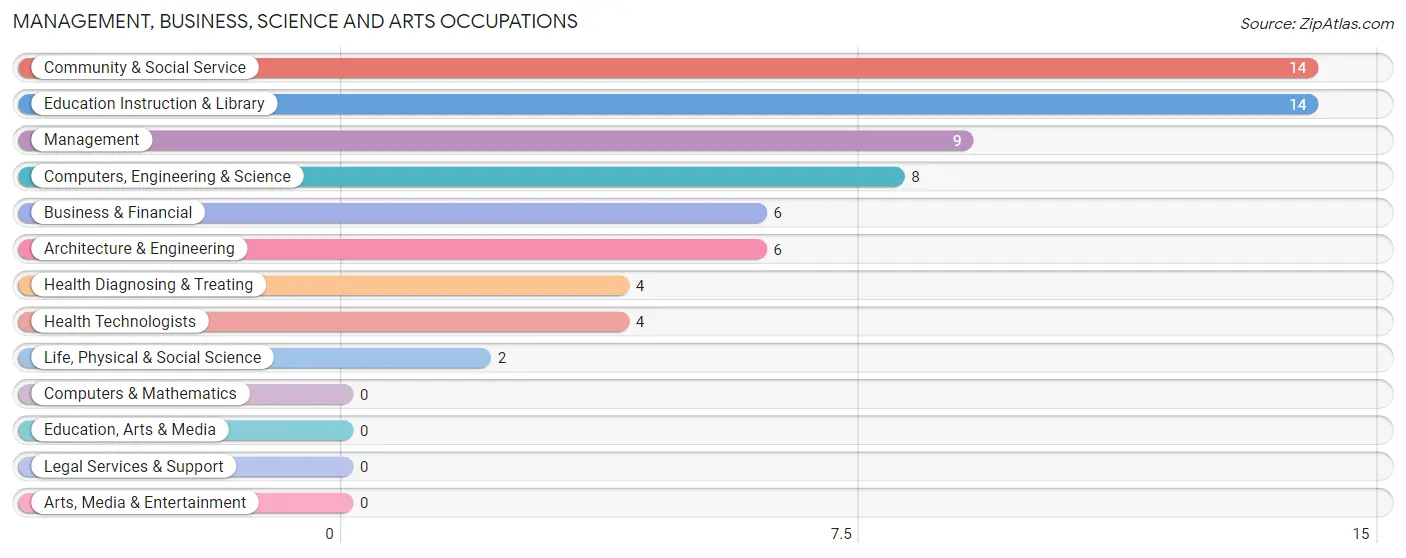
Management, Business, Science and Arts Occupations by Sex
Within the Management, Business, Science and Arts occupations in Ontario, the most male-oriented occupations are Computers, Engineering & Science (100.0%), Architecture & Engineering (100.0%), and Life, Physical & Social Science (100.0%), while the most female-oriented occupations are Health Diagnosing & Treating (100.0%), Health Technologists (100.0%), and Management (66.7%).
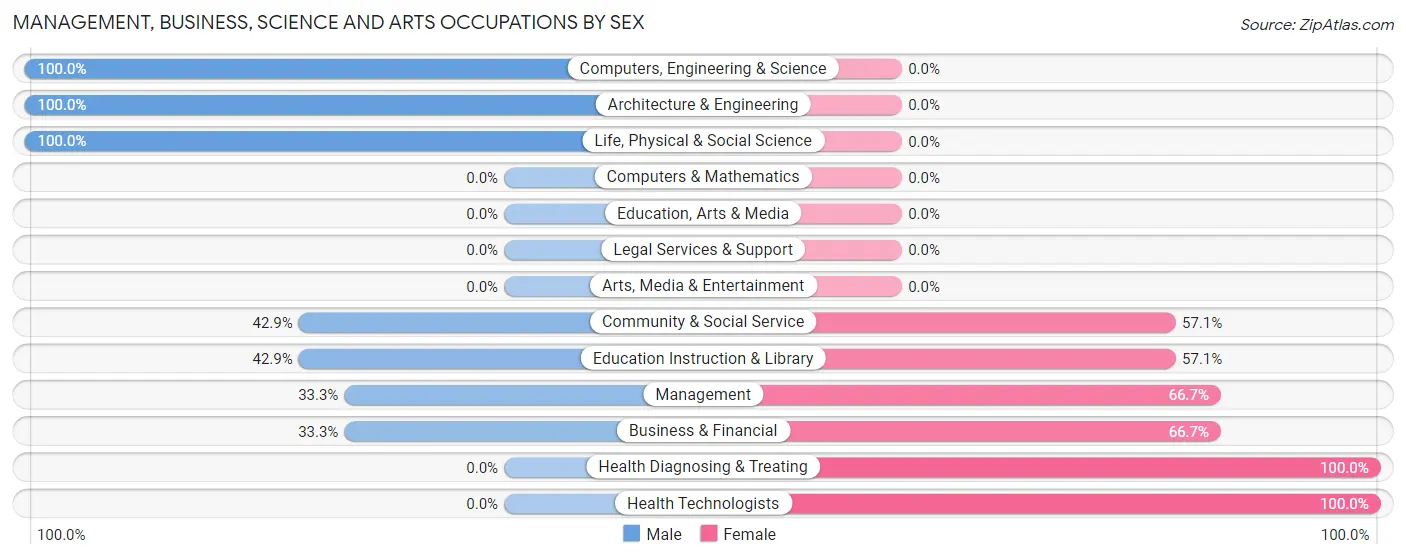
| Occupation | Male | Female |
| Management | 3 (33.3%) | 6 (66.7%) |
| Business & Financial | 2 (33.3%) | 4 (66.7%) |
| Computers, Engineering & Science | 8 (100.0%) | 0 (0.0%) |
| Computers & Mathematics | 0 (0.0%) | 0 (0.0%) |
| Architecture & Engineering | 6 (100.0%) | 0 (0.0%) |
| Life, Physical & Social Science | 2 (100.0%) | 0 (0.0%) |
| Community & Social Service | 6 (42.9%) | 8 (57.1%) |
| Education, Arts & Media | 0 (0.0%) | 0 (0.0%) |
| Legal Services & Support | 0 (0.0%) | 0 (0.0%) |
| Education Instruction & Library | 6 (42.9%) | 8 (57.1%) |
| Arts, Media & Entertainment | 0 (0.0%) | 0 (0.0%) |
| Health Diagnosing & Treating | 0 (0.0%) | 4 (100.0%) |
| Health Technologists | 0 (0.0%) | 4 (100.0%) |
| Total (Category) | 19 (46.3%) | 22 (53.7%) |
| Total (Overall) | 107 (59.4%) | 73 (40.6%) |
Services Occupations
The most common Services occupations in Ontario are Food Preparation & Serving (11 | 6.1%), Healthcare Support (2 | 1.1%), and Cleaning & Maintenance (1 | 0.6%).

Services Occupations by Sex

| Occupation | Male | Female |
| Healthcare Support | 0 (0.0%) | 2 (100.0%) |
| Security & Protection | 0 (0.0%) | 0 (0.0%) |
| Firefighting & Prevention | 0 (0.0%) | 0 (0.0%) |
| Law Enforcement | 0 (0.0%) | 0 (0.0%) |
| Food Preparation & Serving | 5 (45.5%) | 6 (54.5%) |
| Cleaning & Maintenance | 0 (0.0%) | 1 (100.0%) |
| Personal Care & Service | 0 (0.0%) | 0 (0.0%) |
| Total (Category) | 5 (35.7%) | 9 (64.3%) |
| Total (Overall) | 107 (59.4%) | 73 (40.6%) |
Sales and Office Occupations
The most common Sales and Office occupations in Ontario are Office & Administration (24 | 13.3%), and Sales & Related (7 | 3.9%).

Sales and Office Occupations by Sex

| Occupation | Male | Female |
| Sales & Related | 3 (42.9%) | 4 (57.1%) |
| Office & Administration | 2 (8.3%) | 22 (91.7%) |
| Total (Category) | 5 (16.1%) | 26 (83.9%) |
| Total (Overall) | 107 (59.4%) | 73 (40.6%) |
Natural Resources, Construction and Maintenance Occupations
The most common Natural Resources, Construction and Maintenance occupations in Ontario are Installation, Maintenance & Repair (10 | 5.6%), Farming, Fishing & Forestry (2 | 1.1%), and Construction & Extraction (2 | 1.1%).

Natural Resources, Construction and Maintenance Occupations by Sex

| Occupation | Male | Female |
| Farming, Fishing & Forestry | 2 (100.0%) | 0 (0.0%) |
| Construction & Extraction | 2 (100.0%) | 0 (0.0%) |
| Installation, Maintenance & Repair | 10 (100.0%) | 0 (0.0%) |
| Total (Category) | 14 (100.0%) | 0 (0.0%) |
| Total (Overall) | 107 (59.4%) | 73 (40.6%) |
Production, Transportation and Moving Occupations
The most common Production, Transportation and Moving occupations in Ontario are Material Moving (40 | 22.2%), Production (36 | 20.0%), and Transportation (4 | 2.2%).

Production, Transportation and Moving Occupations by Sex

| Occupation | Male | Female |
| Production | 26 (72.2%) | 10 (27.8%) |
| Transportation | 2 (50.0%) | 2 (50.0%) |
| Material Moving | 36 (90.0%) | 4 (10.0%) |
| Total (Category) | 64 (80.0%) | 16 (20.0%) |
| Total (Overall) | 107 (59.4%) | 73 (40.6%) |
Employment Industries by Sex in Ontario
Employment Industries in Ontario
The major employment industries in Ontario include Manufacturing (66 | 36.7%), Retail Trade (25 | 13.9%), Educational Services (19 | 10.6%), Health Care & Social Assistance (16 | 8.9%), and Accommodation & Food Services (16 | 8.9%).
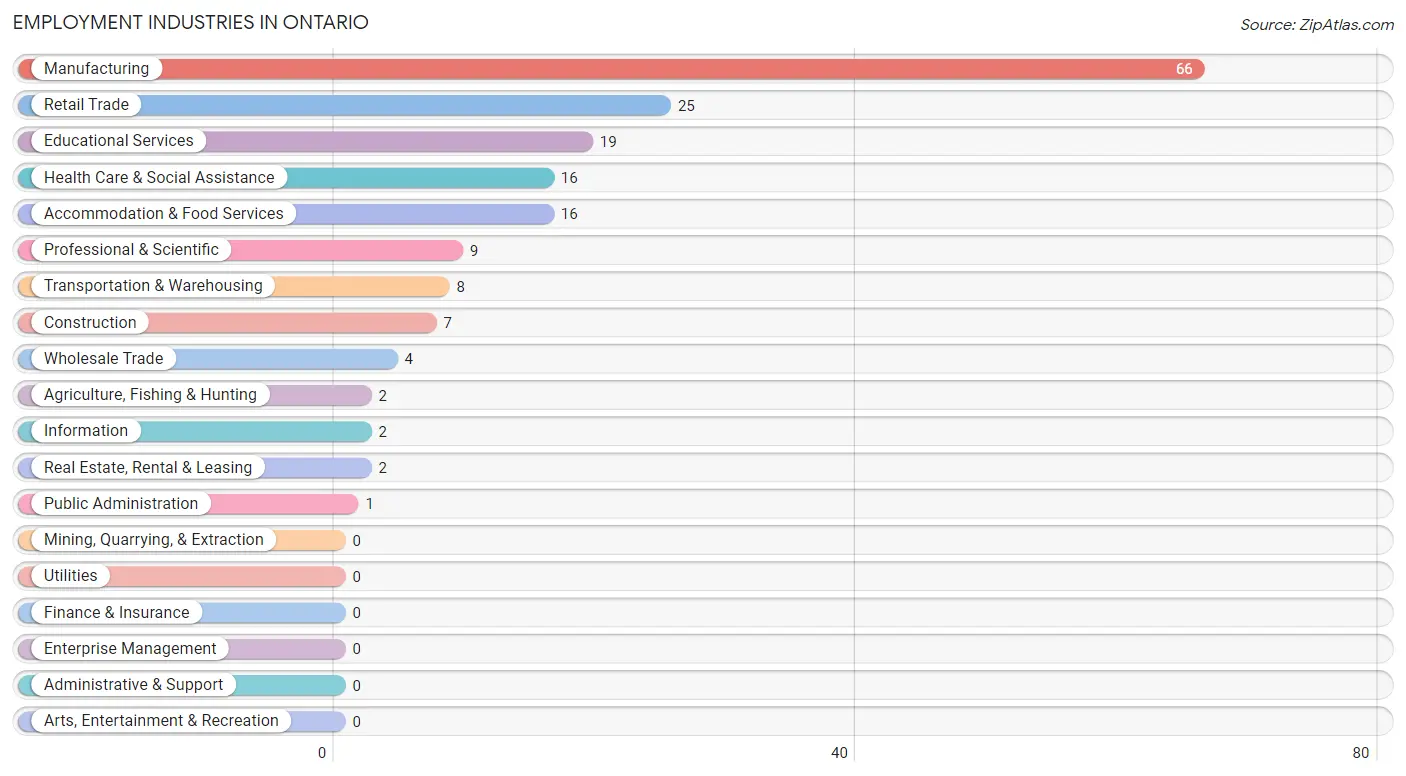
Employment Industries by Sex in Ontario
The Ontario industries that see more men than women are Agriculture, Fishing & Hunting (100.0%), Information (100.0%), and Professional & Scientific (100.0%), whereas the industries that tend to have a higher number of women are Wholesale Trade (100.0%), Real Estate, Rental & Leasing (100.0%), and Health Care & Social Assistance (100.0%).
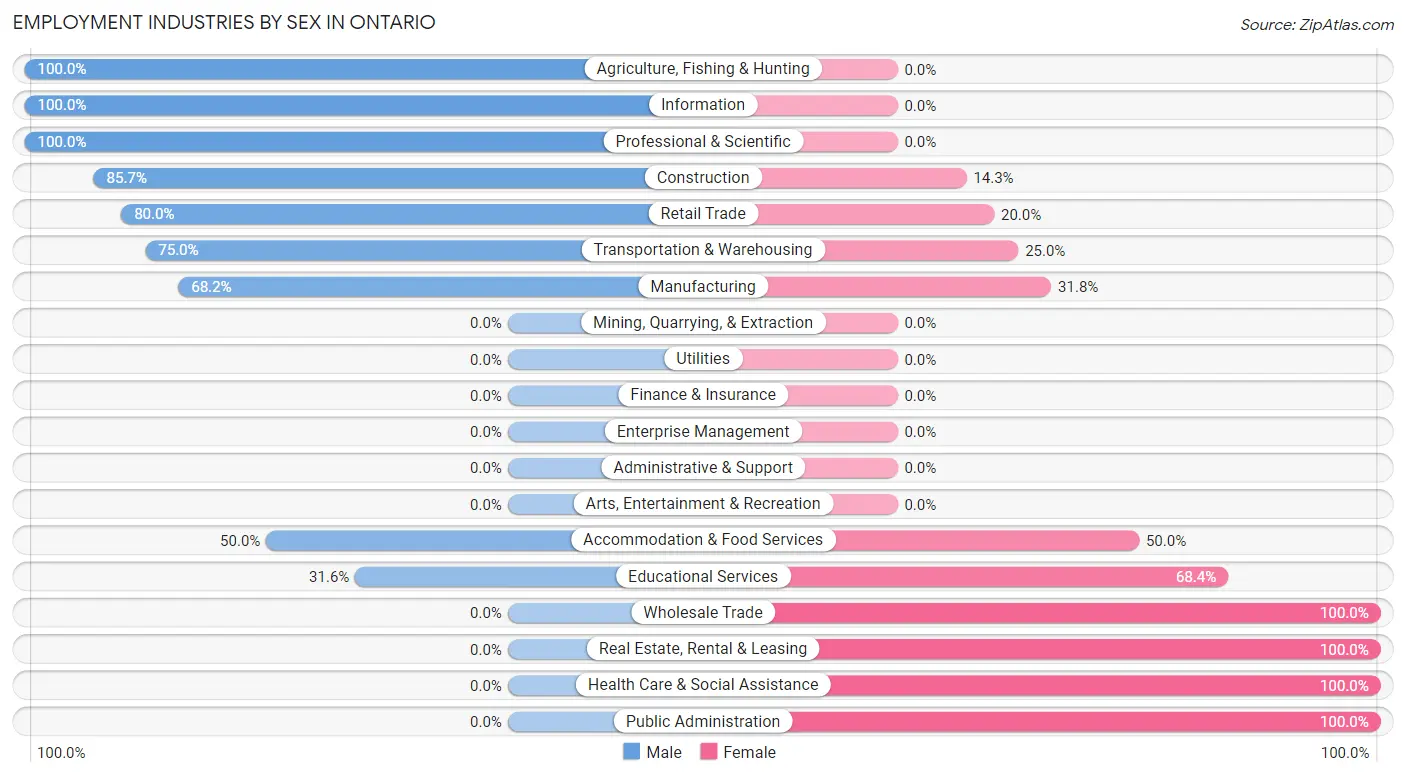
| Industry | Male | Female |
| Agriculture, Fishing & Hunting | 2 (100.0%) | 0 (0.0%) |
| Mining, Quarrying, & Extraction | 0 (0.0%) | 0 (0.0%) |
| Construction | 6 (85.7%) | 1 (14.3%) |
| Manufacturing | 45 (68.2%) | 21 (31.8%) |
| Wholesale Trade | 0 (0.0%) | 4 (100.0%) |
| Retail Trade | 20 (80.0%) | 5 (20.0%) |
| Transportation & Warehousing | 6 (75.0%) | 2 (25.0%) |
| Utilities | 0 (0.0%) | 0 (0.0%) |
| Information | 2 (100.0%) | 0 (0.0%) |
| Finance & Insurance | 0 (0.0%) | 0 (0.0%) |
| Real Estate, Rental & Leasing | 0 (0.0%) | 2 (100.0%) |
| Professional & Scientific | 9 (100.0%) | 0 (0.0%) |
| Enterprise Management | 0 (0.0%) | 0 (0.0%) |
| Administrative & Support | 0 (0.0%) | 0 (0.0%) |
| Educational Services | 6 (31.6%) | 13 (68.4%) |
| Health Care & Social Assistance | 0 (0.0%) | 16 (100.0%) |
| Arts, Entertainment & Recreation | 0 (0.0%) | 0 (0.0%) |
| Accommodation & Food Services | 8 (50.0%) | 8 (50.0%) |
| Public Administration | 0 (0.0%) | 1 (100.0%) |
| Total | 107 (59.4%) | 73 (40.6%) |
Education in Ontario
School Enrollment in Ontario
The most common levels of schooling among the 112 students in Ontario are middle school (40 | 35.7%), high school (33 | 29.5%), and elementary school (27 | 24.1%).

| School Level | # Students | % Students |
| Nursery / Preschool | 5 | 4.5% |
| Kindergarten | 2 | 1.8% |
| Elementary School | 27 | 24.1% |
| Middle School | 40 | 35.7% |
| High School | 33 | 29.5% |
| College / Undergraduate | 3 | 2.7% |
| Graduate / Professional | 2 | 1.8% |
| Total | 112 | 100.0% |
School Enrollment by Age by Funding Source in Ontario
Out of a total of 112 students who are enrolled in schools in Ontario, 9 (8.0%) attend a private institution, while the remaining 103 (92.0%) are enrolled in public schools. The age group of 25 to 34 year olds has the highest likelihood of being enrolled in private schools, with 4 (100.0% in the age bracket) enrolled. Conversely, the age group of 3 to 4 year olds has the lowest likelihood of being enrolled in a private school, with 2 (100.0% in the age bracket) attending a public institution.

| Age Bracket | Public School | Private School |
| 3 to 4 Year Olds | 2 (100.0%) | 0 (0.0%) |
| 5 to 9 Year Old | 24 (92.3%) | 2 (7.7%) |
| 10 to 14 Year Olds | 46 (95.8%) | 2 (4.2%) |
| 15 to 17 Year Olds | 28 (96.6%) | 1 (3.5%) |
| 18 to 19 Year Olds | 0 (0.0%) | 0 (0.0%) |
| 20 to 24 Year Olds | 0 (0.0%) | 0 (0.0%) |
| 25 to 34 Year Olds | 0 (0.0%) | 4 (100.0%) |
| 35 Years and over | 3 (100.0%) | 0 (0.0%) |
| Total | 103 (92.0%) | 9 (8.0%) |
Educational Attainment by Field of Study in Ontario
Science & technology (9 | 26.5%), education (8 | 23.5%), business (4 | 11.8%), computers & mathematics (3 | 8.8%), and bio, nature & agricultural (2 | 5.9%) are the most common fields of study among 34 individuals in Ontario who have obtained a bachelor's degree or higher.
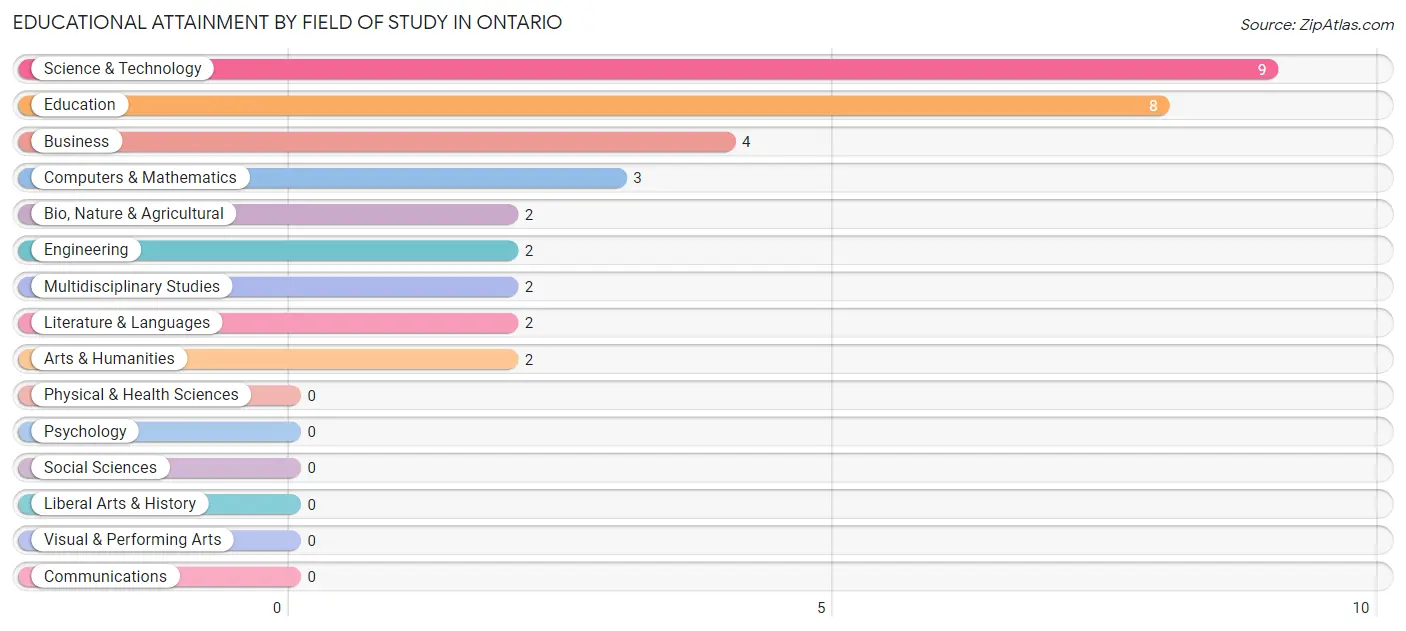
| Field of Study | # Graduates | % Graduates |
| Computers & Mathematics | 3 | 8.8% |
| Bio, Nature & Agricultural | 2 | 5.9% |
| Physical & Health Sciences | 0 | 0.0% |
| Psychology | 0 | 0.0% |
| Social Sciences | 0 | 0.0% |
| Engineering | 2 | 5.9% |
| Multidisciplinary Studies | 2 | 5.9% |
| Science & Technology | 9 | 26.5% |
| Business | 4 | 11.8% |
| Education | 8 | 23.5% |
| Literature & Languages | 2 | 5.9% |
| Liberal Arts & History | 0 | 0.0% |
| Visual & Performing Arts | 0 | 0.0% |
| Communications | 0 | 0.0% |
| Arts & Humanities | 2 | 5.9% |
| Total | 34 | 100.0% |
Transportation & Commute in Ontario
Vehicle Availability by Sex in Ontario
The most prevalent vehicle ownership categories in Ontario are males with 2 vehicles (64, accounting for 59.8%) and females with 2 vehicles (37, making up 90.1%).

| Vehicles Available | Male | Female |
| No Vehicle | 9 (8.4%) | 2 (2.8%) |
| 1 Vehicle | 2 (1.9%) | 7 (9.9%) |
| 2 Vehicles | 64 (59.8%) | 37 (52.1%) |
| 3 Vehicles | 19 (17.8%) | 17 (23.9%) |
| 4 Vehicles | 13 (12.1%) | 8 (11.3%) |
| 5 or more Vehicles | 0 (0.0%) | 0 (0.0%) |
| Total | 107 (100.0%) | 71 (100.0%) |
Commute Time in Ontario
The most frequently occuring commute durations in Ontario are 5 to 9 minutes (32 commuters, 18.2%), 30 to 34 minutes (27 commuters, 15.3%), and 20 to 24 minutes (25 commuters, 14.2%).
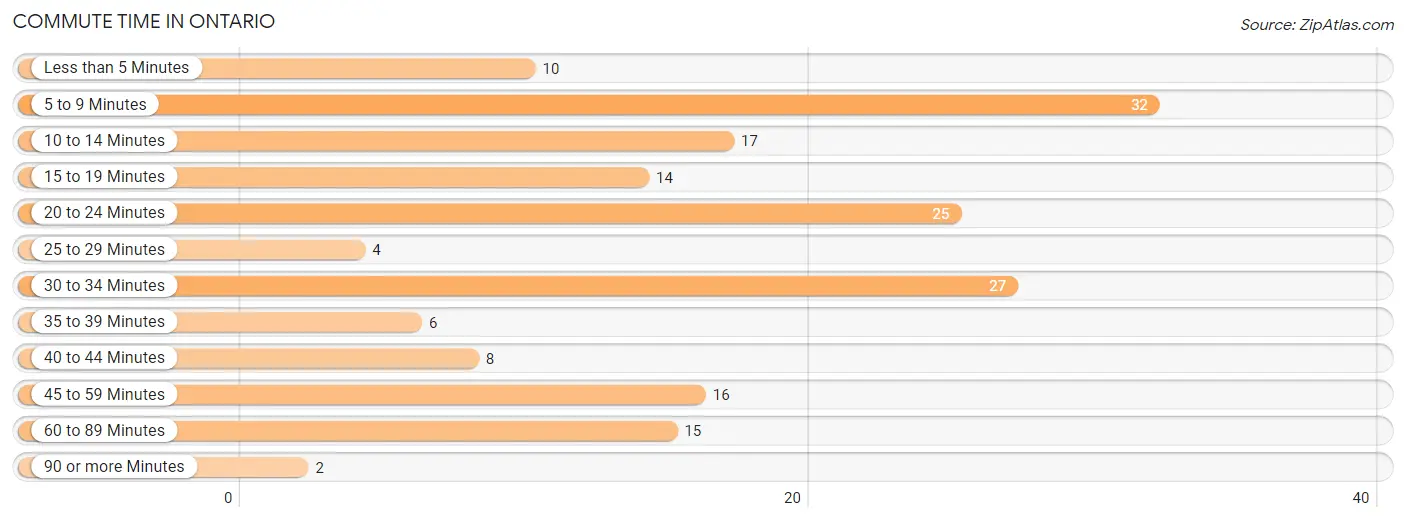
| Commute Time | # Commuters | % Commuters |
| Less than 5 Minutes | 10 | 5.7% |
| 5 to 9 Minutes | 32 | 18.2% |
| 10 to 14 Minutes | 17 | 9.7% |
| 15 to 19 Minutes | 14 | 8.0% |
| 20 to 24 Minutes | 25 | 14.2% |
| 25 to 29 Minutes | 4 | 2.3% |
| 30 to 34 Minutes | 27 | 15.3% |
| 35 to 39 Minutes | 6 | 3.4% |
| 40 to 44 Minutes | 8 | 4.5% |
| 45 to 59 Minutes | 16 | 9.1% |
| 60 to 89 Minutes | 15 | 8.5% |
| 90 or more Minutes | 2 | 1.1% |
Commute Time by Sex in Ontario
The most common commute times in Ontario are 20 to 24 minutes (20 commuters, 18.7%) for males and 5 to 9 minutes (19 commuters, 27.5%) for females.
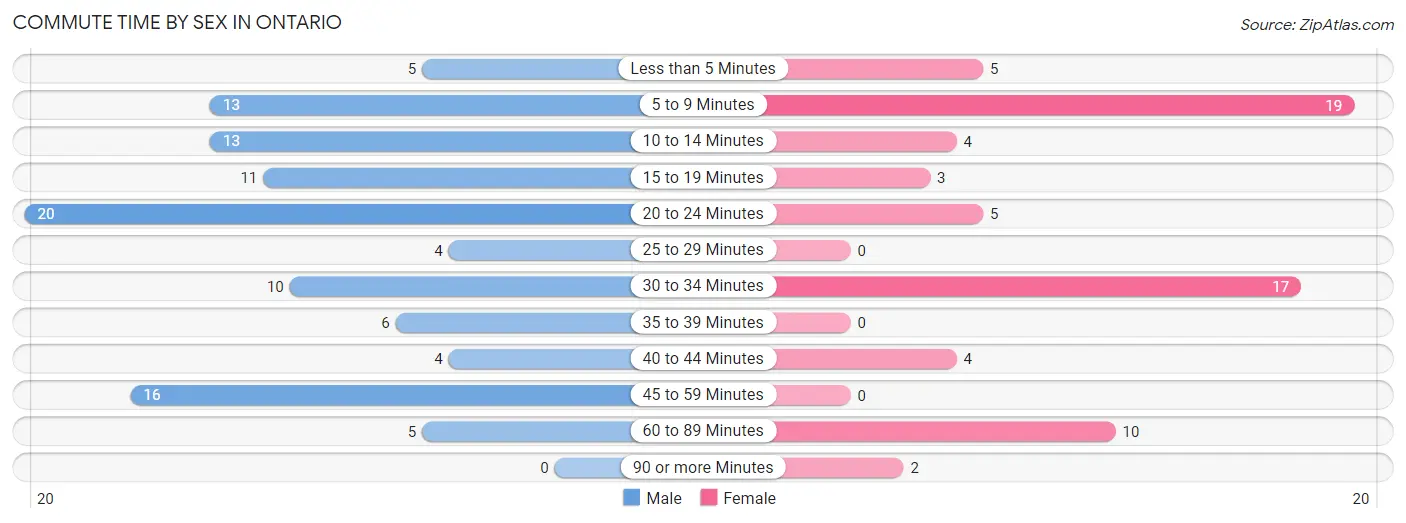
| Commute Time | Male | Female |
| Less than 5 Minutes | 5 (4.7%) | 5 (7.2%) |
| 5 to 9 Minutes | 13 (12.1%) | 19 (27.5%) |
| 10 to 14 Minutes | 13 (12.1%) | 4 (5.8%) |
| 15 to 19 Minutes | 11 (10.3%) | 3 (4.3%) |
| 20 to 24 Minutes | 20 (18.7%) | 5 (7.2%) |
| 25 to 29 Minutes | 4 (3.7%) | 0 (0.0%) |
| 30 to 34 Minutes | 10 (9.3%) | 17 (24.6%) |
| 35 to 39 Minutes | 6 (5.6%) | 0 (0.0%) |
| 40 to 44 Minutes | 4 (3.7%) | 4 (5.8%) |
| 45 to 59 Minutes | 16 (14.9%) | 0 (0.0%) |
| 60 to 89 Minutes | 5 (4.7%) | 10 (14.5%) |
| 90 or more Minutes | 0 (0.0%) | 2 (2.9%) |
Time of Departure to Work by Sex in Ontario
The most frequent times of departure to work in Ontario are 7:00 AM to 7:29 AM (19, 17.8%) for males and 5:30 AM to 5:59 AM (10, 14.5%) for females.
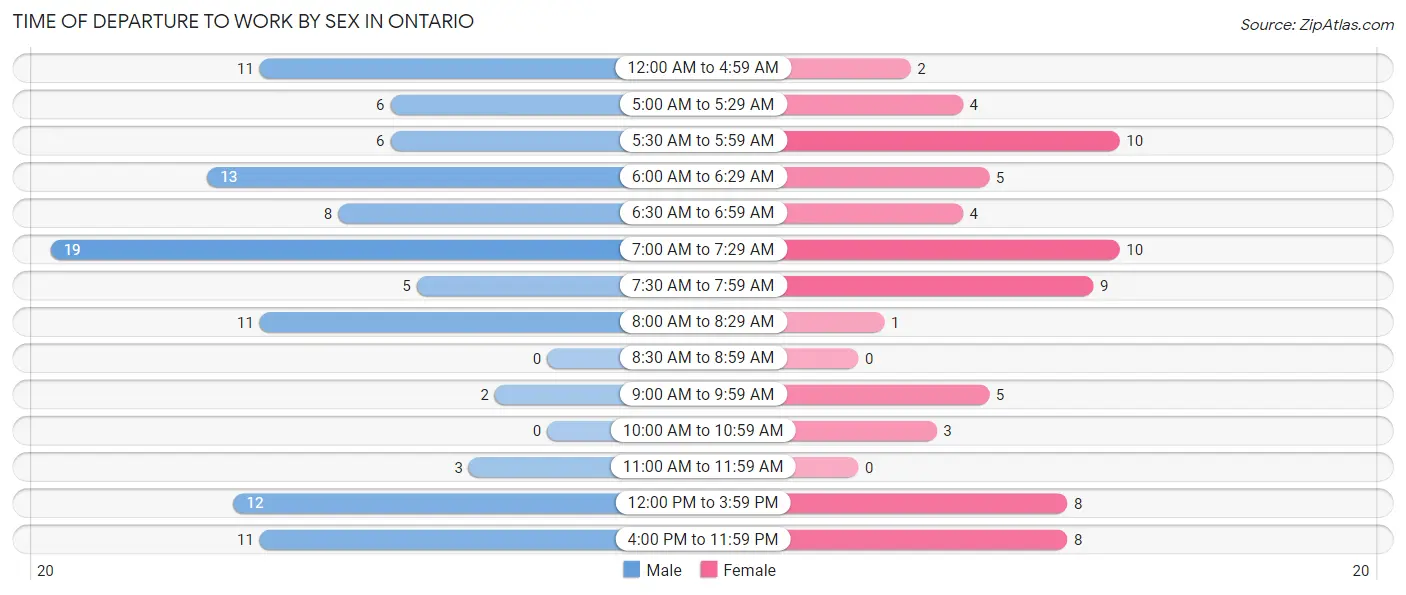
| Time of Departure | Male | Female |
| 12:00 AM to 4:59 AM | 11 (10.3%) | 2 (2.9%) |
| 5:00 AM to 5:29 AM | 6 (5.6%) | 4 (5.8%) |
| 5:30 AM to 5:59 AM | 6 (5.6%) | 10 (14.5%) |
| 6:00 AM to 6:29 AM | 13 (12.1%) | 5 (7.2%) |
| 6:30 AM to 6:59 AM | 8 (7.5%) | 4 (5.8%) |
| 7:00 AM to 7:29 AM | 19 (17.8%) | 10 (14.5%) |
| 7:30 AM to 7:59 AM | 5 (4.7%) | 9 (13.0%) |
| 8:00 AM to 8:29 AM | 11 (10.3%) | 1 (1.5%) |
| 8:30 AM to 8:59 AM | 0 (0.0%) | 0 (0.0%) |
| 9:00 AM to 9:59 AM | 2 (1.9%) | 5 (7.2%) |
| 10:00 AM to 10:59 AM | 0 (0.0%) | 3 (4.3%) |
| 11:00 AM to 11:59 AM | 3 (2.8%) | 0 (0.0%) |
| 12:00 PM to 3:59 PM | 12 (11.2%) | 8 (11.6%) |
| 4:00 PM to 11:59 PM | 11 (10.3%) | 8 (11.6%) |
| Total | 107 (100.0%) | 69 (100.0%) |
Housing Occupancy in Ontario
Occupancy by Ownership in Ontario
Of the total 170 dwellings in Ontario, owner-occupied units account for 144 (84.7%), while renter-occupied units make up 26 (15.3%).

| Occupancy | # Housing Units | % Housing Units |
| Owner Occupied Housing Units | 144 | 84.7% |
| Renter-Occupied Housing Units | 26 | 15.3% |
| Total Occupied Housing Units | 170 | 100.0% |
Occupancy by Household Size in Ontario

| Household Size | # Housing Units | % Housing Units |
| 1-Person Household | 68 | 40.0% |
| 2-Person Household | 50 | 29.4% |
| 3-Person Household | 10 | 5.9% |
| 4+ Person Household | 42 | 24.7% |
| Total Housing Units | 170 | 100.0% |
Occupancy by Ownership by Household Size in Ontario

| Household Size | Owner-occupied | Renter-occupied |
| 1-Person Household | 49 (72.1%) | 19 (27.9%) |
| 2-Person Household | 48 (96.0%) | 2 (4.0%) |
| 3-Person Household | 10 (100.0%) | 0 (0.0%) |
| 4+ Person Household | 37 (88.1%) | 5 (11.9%) |
| Total Housing Units | 144 (84.7%) | 26 (15.3%) |
Occupancy by Educational Attainment in Ontario

| Household Size | Owner-occupied | Renter-occupied |
| Less than High School | 18 (58.1%) | 13 (41.9%) |
| High School Diploma | 49 (84.5%) | 9 (15.5%) |
| College/Associate Degree | 56 (93.3%) | 4 (6.7%) |
| Bachelor's Degree or higher | 21 (100.0%) | 0 (0.0%) |
Occupancy by Age of Householder in Ontario

| Age Bracket | # Households | % Households |
| Under 35 Years | 33 | 19.4% |
| 35 to 44 Years | 33 | 19.4% |
| 45 to 54 Years | 17 | 10.0% |
| 55 to 64 Years | 31 | 18.2% |
| 65 to 74 Years | 24 | 14.1% |
| 75 to 84 Years | 20 | 11.8% |
| 85 Years and Over | 12 | 7.1% |
| Total | 170 | 100.0% |
Housing Finances in Ontario
Median Income by Occupancy in Ontario

| Occupancy Type | # Households | Median Income |
| Owner-Occupied | 144 (84.7%) | $70,625 |
| Renter-Occupied | 26 (15.3%) | $42,857 |
| Average | 170 (100.0%) | $57,500 |
Occupancy by Householder Income Bracket in Ontario
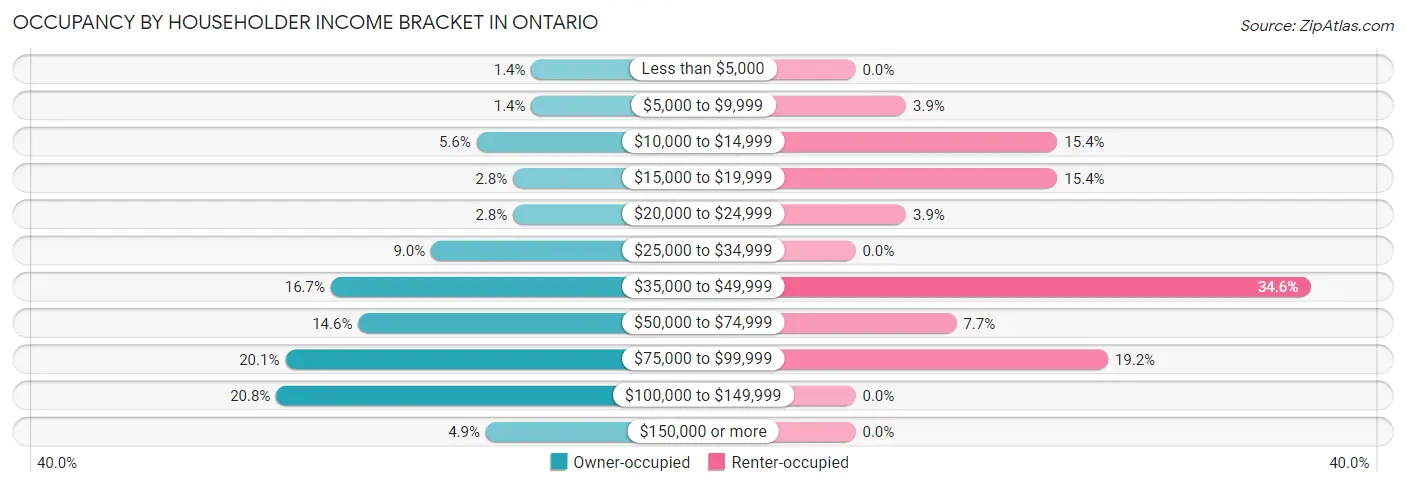
| Income Bracket | Owner-occupied | Renter-occupied |
| Less than $5,000 | 2 (1.4%) | 0 (0.0%) |
| $5,000 to $9,999 | 2 (1.4%) | 1 (3.8%) |
| $10,000 to $14,999 | 8 (5.6%) | 4 (15.4%) |
| $15,000 to $19,999 | 4 (2.8%) | 4 (15.4%) |
| $20,000 to $24,999 | 4 (2.8%) | 1 (3.8%) |
| $25,000 to $34,999 | 13 (9.0%) | 0 (0.0%) |
| $35,000 to $49,999 | 24 (16.7%) | 9 (34.6%) |
| $50,000 to $74,999 | 21 (14.6%) | 2 (7.7%) |
| $75,000 to $99,999 | 29 (20.1%) | 5 (19.2%) |
| $100,000 to $149,999 | 30 (20.8%) | 0 (0.0%) |
| $150,000 or more | 7 (4.9%) | 0 (0.0%) |
| Total | 144 (100.0%) | 26 (100.0%) |
Monthly Housing Cost Tiers in Ontario

| Monthly Cost | Owner-occupied | Renter-occupied |
| Less than $300 | 14 (9.7%) | 7 (26.9%) |
| $300 to $499 | 19 (13.2%) | 3 (11.5%) |
| $500 to $799 | 47 (32.6%) | 2 (7.7%) |
| $800 to $999 | 10 (6.9%) | 11 (42.3%) |
| $1,000 to $1,499 | 24 (16.7%) | 3 (11.5%) |
| $1,500 to $1,999 | 26 (18.1%) | 0 (0.0%) |
| $2,000 to $2,499 | 3 (2.1%) | 0 (0.0%) |
| $2,500 to $2,999 | 1 (0.7%) | 0 (0.0%) |
| $3,000 or more | 0 (0.0%) | 0 (0.0%) |
| Total | 144 (100.0%) | 26 (100.0%) |
Physical Housing Characteristics in Ontario
Housing Structures in Ontario

| Structure Type | # Housing Units | % Housing Units |
| Single Unit, Detached | 129 | 75.9% |
| Single Unit, Attached | 0 | 0.0% |
| 2 Unit Apartments | 0 | 0.0% |
| 3 or 4 Unit Apartments | 0 | 0.0% |
| 5 to 9 Unit Apartments | 4 | 2.4% |
| 10 or more Apartments | 6 | 3.5% |
| Mobile Home / Other | 31 | 18.2% |
| Total | 170 | 100.0% |
Housing Structures by Occupancy in Ontario

| Structure Type | Owner-occupied | Renter-occupied |
| Single Unit, Detached | 120 (93.0%) | 9 (7.0%) |
| Single Unit, Attached | 0 (0.0%) | 0 (0.0%) |
| 2 Unit Apartments | 0 (0.0%) | 0 (0.0%) |
| 3 or 4 Unit Apartments | 0 (0.0%) | 0 (0.0%) |
| 5 to 9 Unit Apartments | 0 (0.0%) | 4 (100.0%) |
| 10 or more Apartments | 0 (0.0%) | 6 (100.0%) |
| Mobile Home / Other | 24 (77.4%) | 7 (22.6%) |
| Total | 144 (84.7%) | 26 (15.3%) |
Housing Structures by Number of Rooms in Ontario

| Number of Rooms | Owner-occupied | Renter-occupied |
| 1 Room | 0 (0.0%) | 0 (0.0%) |
| 2 or 3 Rooms | 6 (4.2%) | 1 (3.8%) |
| 4 or 5 Rooms | 59 (41.0%) | 20 (76.9%) |
| 6 or 7 Rooms | 49 (34.0%) | 3 (11.5%) |
| 8 or more Rooms | 30 (20.8%) | 2 (7.7%) |
| Total | 144 (100.0%) | 26 (100.0%) |
Housing Structure by Heating Type in Ontario

| Heating Type | Owner-occupied | Renter-occupied |
| Utility Gas | 16 (11.1%) | 4 (15.4%) |
| Bottled, Tank, or LP Gas | 116 (80.6%) | 12 (46.2%) |
| Electricity | 6 (4.2%) | 8 (30.8%) |
| Fuel Oil or Kerosene | 0 (0.0%) | 0 (0.0%) |
| Coal or Coke | 0 (0.0%) | 0 (0.0%) |
| All other Fuels | 6 (4.2%) | 2 (7.7%) |
| No Fuel Used | 0 (0.0%) | 0 (0.0%) |
| Total | 144 (100.0%) | 26 (100.0%) |
Household Vehicle Usage in Ontario

| Vehicles per Household | Owner-occupied | Renter-occupied |
| No Vehicle | 5 (3.5%) | 11 (42.3%) |
| 1 Vehicle | 40 (27.8%) | 10 (38.5%) |
| 2 Vehicles | 66 (45.8%) | 3 (11.5%) |
| 3 or more Vehicles | 33 (22.9%) | 2 (7.7%) |
| Total | 144 (100.0%) | 26 (100.0%) |
Real Estate & Mortgages in Ontario
Real Estate and Mortgage Overview in Ontario
| Characteristic | Without Mortgage | With Mortgage |
| Housing Units | 72 | 72 |
| Median Property Value | $86,000 | $159,400 |
| Median Household Income | $37,222 | $4 |
| Monthly Housing Costs | $527 | $0 |
| Real Estate Taxes | $1,389 | $2 |
Property Value by Mortgage Status in Ontario

| Property Value | Without Mortgage | With Mortgage |
| Less than $50,000 | 22 (30.6%) | 6 (8.3%) |
| $50,000 to $99,999 | 23 (31.9%) | 1 (1.4%) |
| $100,000 to $299,999 | 27 (37.5%) | 63 (87.5%) |
| $300,000 to $499,999 | 0 (0.0%) | 2 (2.8%) |
| $500,000 to $749,999 | 0 (0.0%) | 0 (0.0%) |
| $750,000 to $999,999 | 0 (0.0%) | 0 (0.0%) |
| $1,000,000 or more | 0 (0.0%) | 0 (0.0%) |
| Total | 72 (100.0%) | 72 (100.0%) |
Household Income by Mortgage Status in Ontario

| Household Income | Without Mortgage | With Mortgage |
| Less than $10,000 | 2 (2.8%) | 0 (0.0%) |
| $10,000 to $24,999 | 13 (18.1%) | 2 (2.8%) |
| $25,000 to $34,999 | 13 (18.1%) | 3 (4.2%) |
| $35,000 to $49,999 | 15 (20.8%) | 0 (0.0%) |
| $50,000 to $74,999 | 10 (13.9%) | 9 (12.5%) |
| $75,000 to $99,999 | 16 (22.2%) | 11 (15.3%) |
| $100,000 to $149,999 | 0 (0.0%) | 13 (18.1%) |
| $150,000 or more | 3 (4.2%) | 30 (41.7%) |
| Total | 72 (100.0%) | 72 (100.0%) |
Property Value to Household Income Ratio in Ontario

| Value-to-Income Ratio | Without Mortgage | With Mortgage |
| Less than 2.0x | 31 (43.1%) | 96,250 (133,680.6%) |
| 2.0x to 2.9x | 15 (20.8%) | 48 (66.7%) |
| 3.0x to 3.9x | 5 (6.9%) | 11 (15.3%) |
| 4.0x or more | 20 (27.8%) | 6 (8.3%) |
| Total | 72 (100.0%) | 72 (100.0%) |
Real Estate Taxes by Mortgage Status in Ontario

| Property Taxes | Without Mortgage | With Mortgage |
| Less than $800 | 16 (22.2%) | 0 (0.0%) |
| $800 to $1,499 | 21 (29.2%) | 4 (5.6%) |
| $800 to $1,499 | 29 (40.3%) | 6 (8.3%) |
| Total | 72 (100.0%) | 72 (100.0%) |
Health & Disability in Ontario
Health Insurance Coverage by Age in Ontario

| Age Bracket | With Coverage | Without Coverage |
| Under 6 Years | 37 (100.0%) | 0 (0.0%) |
| 6 to 18 Years | 107 (100.0%) | 0 (0.0%) |
| 19 to 25 Years | 19 (100.0%) | 0 (0.0%) |
| 26 to 34 Years | 41 (91.1%) | 4 (8.9%) |
| 35 to 44 Years | 46 (85.2%) | 8 (14.8%) |
| 45 to 54 Years | 35 (94.6%) | 2 (5.4%) |
| 55 to 64 Years | 41 (87.2%) | 6 (12.8%) |
| 65 to 74 Years | 32 (100.0%) | 0 (0.0%) |
| 75 Years and older | 35 (94.6%) | 2 (5.4%) |
| Total | 393 (94.7%) | 22 (5.3%) |
Health Insurance Coverage by Citizenship Status in Ontario

| Citizenship Status | With Coverage | Without Coverage |
| Native Born | 37 (100.0%) | 0 (0.0%) |
| Foreign Born, Citizen | 107 (100.0%) | 0 (0.0%) |
| Foreign Born, not a Citizen | 19 (100.0%) | 0 (0.0%) |
Health Insurance Coverage by Household Income in Ontario

| Household Income | With Coverage | Without Coverage |
| Under $25,000 | 31 (100.0%) | 0 (0.0%) |
| $25,000 to $49,999 | 78 (90.7%) | 8 (9.3%) |
| $50,000 to $74,999 | 63 (100.0%) | 0 (0.0%) |
| $75,000 to $99,999 | 90 (86.5%) | 14 (13.5%) |
| $100,000 and over | 131 (100.0%) | 0 (0.0%) |
Public vs Private Health Insurance Coverage by Age in Ontario

| Age Bracket | Public Insurance | Private Insurance |
| Under 6 | 8 (21.6%) | 29 (78.4%) |
| 6 to 18 Years | 22 (20.6%) | 91 (85.1%) |
| 19 to 25 Years | 5 (26.3%) | 14 (73.7%) |
| 25 to 34 Years | 1 (2.2%) | 40 (88.9%) |
| 35 to 44 Years | 11 (20.4%) | 40 (74.1%) |
| 45 to 54 Years | 4 (10.8%) | 33 (89.2%) |
| 55 to 64 Years | 7 (14.9%) | 35 (74.5%) |
| 65 to 74 Years | 31 (96.9%) | 24 (75.0%) |
| 75 Years and over | 35 (94.6%) | 19 (51.3%) |
| Total | 124 (29.9%) | 325 (78.3%) |
Disability Status by Sex by Age in Ontario

| Age Bracket | Male | Female |
| Under 5 Years | 0 (0.0%) | 0 (0.0%) |
| 5 to 17 Years | 5 (13.9%) | 0 (0.0%) |
| 18 to 34 Years | 7 (18.4%) | 0 (0.0%) |
| 35 to 64 Years | 4 (5.6%) | 5 (7.6%) |
| 65 to 74 Years | 0 (0.0%) | 3 (13.6%) |
| 75 Years and over | 10 (71.4%) | 12 (52.2%) |
Disability Class by Sex by Age in Ontario
Disability Class: Hearing Difficulty

| Age Bracket | Male | Female |
| Under 5 Years | 0 (0.0%) | 0 (0.0%) |
| 5 to 17 Years | 0 (0.0%) | 0 (0.0%) |
| 18 to 34 Years | 2 (5.3%) | 0 (0.0%) |
| 35 to 64 Years | 0 (0.0%) | 0 (0.0%) |
| 65 to 74 Years | 0 (0.0%) | 0 (0.0%) |
| 75 Years and over | 0 (0.0%) | 11 (47.8%) |
Disability Class: Vision Difficulty

| Age Bracket | Male | Female |
| Under 5 Years | 0 (0.0%) | 0 (0.0%) |
| 5 to 17 Years | 3 (8.3%) | 0 (0.0%) |
| 18 to 34 Years | 0 (0.0%) | 0 (0.0%) |
| 35 to 64 Years | 0 (0.0%) | 1 (1.5%) |
| 65 to 74 Years | 0 (0.0%) | 0 (0.0%) |
| 75 Years and over | 0 (0.0%) | 3 (13.0%) |
Disability Class: Cognitive Difficulty

| Age Bracket | Male | Female |
| 5 to 17 Years | 5 (13.9%) | 0 (0.0%) |
| 18 to 34 Years | 3 (7.9%) | 0 (0.0%) |
| 35 to 64 Years | 0 (0.0%) | 0 (0.0%) |
| 65 to 74 Years | 0 (0.0%) | 0 (0.0%) |
| 75 Years and over | 10 (71.4%) | 0 (0.0%) |
Disability Class: Ambulatory Difficulty

| Age Bracket | Male | Female |
| 5 to 17 Years | 0 (0.0%) | 0 (0.0%) |
| 18 to 34 Years | 2 (5.3%) | 0 (0.0%) |
| 35 to 64 Years | 0 (0.0%) | 5 (7.6%) |
| 65 to 74 Years | 0 (0.0%) | 3 (13.6%) |
| 75 Years and over | 3 (21.4%) | 4 (17.4%) |
Disability Class: Self-Care Difficulty

| Age Bracket | Male | Female |
| 5 to 17 Years | 0 (0.0%) | 0 (0.0%) |
| 18 to 34 Years | 3 (7.9%) | 0 (0.0%) |
| 35 to 64 Years | 0 (0.0%) | 4 (6.1%) |
| 65 to 74 Years | 0 (0.0%) | 1 (4.5%) |
| 75 Years and over | 2 (14.3%) | 1 (4.3%) |
Technology Access in Ontario
Computing Device Access in Ontario

| Device Type | # Households | % Households |
| Desktop or Laptop | 104 | 61.2% |
| Smartphone | 103 | 60.6% |
| Tablet | 93 | 54.7% |
| No Computing Device | 34 | 20.0% |
| Total | 170 | 100.0% |
Internet Access in Ontario

| Internet Type | # Households | % Households |
| Dial-Up Internet | 12 | 7.1% |
| Broadband Home | 84 | 49.4% |
| Cellular Data Only | 21 | 12.3% |
| Satellite Internet | 11 | 6.5% |
| No Internet | 44 | 25.9% |
| Total | 170 | 100.0% |
Ontario Summary
Ontario is a small town located in the state of Wisconsin, in the United States. It is situated in the southwestern part of the state, in Vernon County. The town is located on the banks of the Kickapoo River, and is surrounded by rolling hills and lush forests. The population of Ontario was 1,845 as of the 2010 census.
History
Ontario was first settled in 1851 by a group of settlers from New York. The town was named after the province of Ontario in Canada, as many of the settlers had come from there. The town was officially incorporated in 1856.
In the late 19th century, Ontario was a thriving agricultural community. The town was home to several sawmills, gristmills, and other businesses. The town also had a railroad station, which connected it to the rest of the state.
In the early 20th century, the town began to decline. Many of the businesses closed, and the population began to dwindle. In the 1950s, the town was revitalized by the construction of a dam on the Kickapoo River. This created a lake, which brought in tourists and new businesses.
Geography
Ontario is located in southwestern Wisconsin, in Vernon County. The town is situated on the banks of the Kickapoo River, and is surrounded by rolling hills and lush forests. The town is located about 25 miles from the city of La Crosse.
The climate in Ontario is humid continental, with cold winters and hot, humid summers. The average annual temperature is around 50 degrees Fahrenheit. The average annual precipitation is around 35 inches.
Economy
The economy of Ontario is largely based on tourism. The town is home to several resorts and campgrounds, which attract visitors from all over the state. The town is also home to several small businesses, including restaurants, shops, and other services.
The town is also home to several manufacturing companies, which produce a variety of products, including furniture, clothing, and electronics. The town is also home to several farms, which produce a variety of crops, including corn, soybeans, and hay.
Demographics
As of the 2010 census, the population of Ontario was 1,845. The racial makeup of the town was 97.3% White, 0.3% African American, 0.2% Native American, 0.3% Asian, 0.1% Pacific Islander, 0.7% from other races, and 1.1% from two or more races. Hispanic or Latino of any race were 1.7% of the population.
The median household income in Ontario was $41,250, and the median family income was $50,000. The per capita income was $20,845. About 11.2% of the population was below the poverty line.
Common Questions
What is Per Capita Income in Ontario?
Per Capita income in Ontario is $25,525.
What is the Median Family Income in Ontario?
Median Family Income in Ontario is $88,571.
What is the Median Household income in Ontario?
Median Household Income in Ontario is $57,500.
What is Income or Wage Gap in Ontario?
Income or Wage Gap in Ontario is 29.2%.
Women in Ontario earn 70.8 cents for every dollar earned by a man.
What is Inequality or Gini Index in Ontario?
Inequality or Gini Index in Ontario is 0.35.
What is the Total Population of Ontario?
Total Population of Ontario is 415.
What is the Total Male Population of Ontario?
Total Male Population of Ontario is 180.
What is the Total Female Population of Ontario?
Total Female Population of Ontario is 235.
What is the Ratio of Males per 100 Females in Ontario?
There are 76.60 Males per 100 Females in Ontario.
What is the Ratio of Females per 100 Males in Ontario?
There are 130.56 Females per 100 Males in Ontario.
What is the Median Population Age in Ontario?
Median Population Age in Ontario is 34.0 Years.
What is the Average Family Size in Ontario
Average Family Size in Ontario is 3.6 People.
What is the Average Household Size in Ontario
Average Household Size in Ontario is 2.4 People.
How Large is the Labor Force in Ontario?
There are 182 People in the Labor Forcein in Ontario.
What is the Percentage of People in the Labor Force in Ontario?
62.1% of People are in the Labor Force in Ontario.
What is the Unemployment Rate in Ontario?
Unemployment Rate in Ontario is 1.1%.